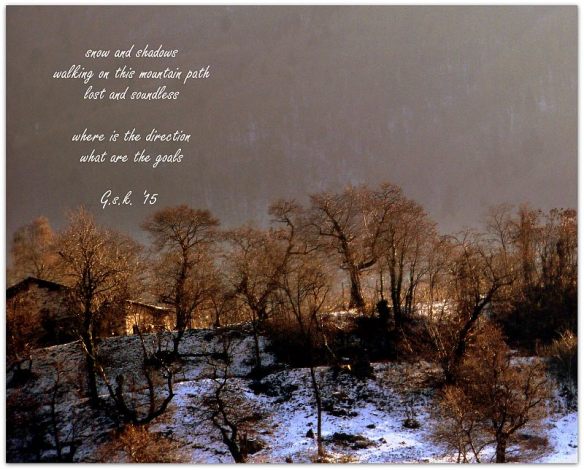snow and shadows
walking on this mountain path
lost and soundless
where is the direction
what are the goals
The above is the tanka I wrote while I was editing the photo … but transcribing the tanka the following variation popped up, and as it feels more like our haiku master of the day Taneda Santoka on Carpe Diem Haiku Kai Special I thought I’d leave it here for your comments:
snowy shadows
this mountain path
lost and voiceless
which direction
what is the goal
© G.s.k. ‘15
As you read above today’s Carpe Diem Special is dedicated to Taneda Santoka(1882-1940) who wrote using the “freestyle haiku” form created by Ogiwara Seisensui (1884-1976) his haiku master. Here are some examples of his work, but first of all here are two quotes by Taneda Santokai:
“Santoka once said: “Days I don’t enjoy: any day I don’t walk, drink sake, and compose haiku.”
And here is another quote of a saying by Santoka: “Westerners try to conquer the mountains. People of the East contemplate the mountains. For us, mountains are not an object of scientific study but a work of art. Patiently I taste the mountains.””
mizu ni kage aru tabibito de aru (SMT)
reflection
in the water
a traveler
my shadow
on the water,
traveler I am.
and our Chèvrefeuilles translation:
shadow
in water
travels
© Chèvrefeuille


very thought provoking. The zen of haiku is becoming more involving and more demanding the more I read. I can relate to your question.
LikeLike
Well … I’ve been interested in Zen far longer than I’ve been interested in haiku to tell the truth .. in this particular haiku though, it was the influence of the guest haiku poet that gave the tone to the ku 🙂 But I’m very glad you could relate!
LikeLike
Oh I can feel this, cara…and leaving my office those last two lines were my questions…I arrived on a somewhat spring day at 2p.m. and left at 10pm. with blowing snow and could not find the sidewalk!
LikeLike
Ah … I do remember Anchorage winters when you relate your experiences … let’s hope the weather begins to settle soon.
LikeLike
Excellent question you’ve posed — much to think about 🙂
LikeLiked by 1 person
Indeed!
LikeLiked by 1 person
What if there are no goals?
LikeLiked by 1 person
Lovely work.
LikeLike
Thanks!
LikeLike
Wow Georgia a wonderful post … I like your first version a lot, but as I read that second version than it overrules my feeling of the first one. Maybe it’s the Zen which is more clear in that second than in that first tanka … really this is a great response and in tune with Taneda Santoka
LikeLike
Thanks you Chèvrefeuille … the second version began as a typographical error … but then i looked at that first error and followed the indication of trimming off the excess. I think you’re right it does reflect Taneda Santoka more than the first one did and it’s definitely more Zen.
LikeLike
I agree with Chevrefeuille – the second version is deeply contemplative, and it is so interesting when put with the first. The 2nd elevates it higher. Definitely, and the zen concept is there. Nice image by the way
LikeLike
Thanks Hamish … I have to agree about the second version … it struck me as very Zen … I must have had a friendly kami on hand as i was transcribing the haiku – the second was born from a typing error… and I’m happy you enjoyed the photo as well 🙂
LikeLike
Well, that’s a mighty accommodating typo! I love how the mountain path becomes lost and voiceless 🙂
LikeLike
I do agree … I sometimes have these problems retyping a piece … which is why I prefer to copy and paste, but as I’d written the haiku in the haiga without first writing it in word … well, I had to retype it and there you are … a variation.
LikeLike
As you and Jen might say, your muse was there jogging your elbow 😉
LikeLike
Definitely … glad to have a jog now and again too!
LikeLike
Love the haiga….. but then the second one is so strong and really in the spirit of our inspiration. Really great typo!
LikeLike
A “stroke” of luck … 🙂
LikeLike